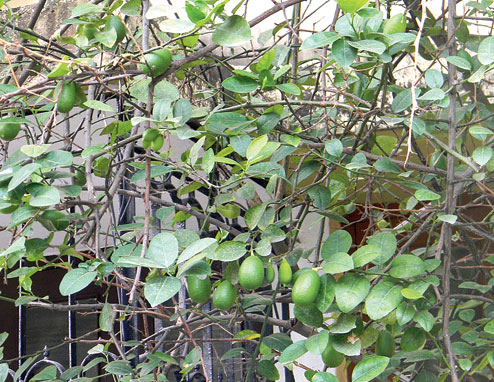
Kagzi Lebu, Acid Lime or Citrus aurantifolia: A Lime by any other name would taste just as sour.
India is perhaps the largest producer of Acid Lime in the world and it is our third most important citrus fruit after Mandarins (Kamala Lebu) and Sweet Oranges (Mausambi). It is cultivated in almost all the states of India and is popular in the gardens of Salt Lake too. Besides the fruit itself, the glossy aromatic foliage makes it an attractive pot plant.
Climate and Soil: Acid Lime is tropical in its climatic requirements. It prefers a sunny aspect and should be protected by windbreaks.
The principal centres of cultivation are the drier regions. It does well in areas where the rainfall does not exceed 1,000mm per annum and it grows even up to 1,000m above mean sea level, provided humidity is low.
In more humid regions of Bengal where rainfall is more than 1,250mm per annum Lime become susceptible to various pests and diseases. Sometimes the tree becomes unproductive and short lived.
Acid Limes tolerate a wide range of soils but deliver the best yield in well-drained, slight acid soil (pH 6 to 6.5). It is highly sensitive to water-logged conditions and loamy soil of uniform texture, well-drained and rich in organic matter is ideal. Alkaline soil and soil high in lime content are not suitable.
Varieties: Though Lime has been in cultivation since ancient times there have not been no improved varieties. It is only recently that scientists of different agricultural university have started developing disease-free prolific bearer cultivars such as Galgal, Ureka, Nepali Round, Seedless Lime and PKM1etc.
Propagation: Most citrus seeds are poly-embryonic and reproduce characteristics of the mother plant. For specific cultivars the usual means of propagation adopted is vegetative propagation. This involves cutting, layering and budding methods. Citrus trees are subject to a number of debilitating virus diseases and for this reason a scion should be selected from an elite mother plant that is free from diseases and which produces large, good quality fruits. The selection of root stock is also important.
Acid Lime is commercially propagated through seeds, which is the cheapest and easiest method. Seedlings can withstand vagaries of nature better, tolerate diseases better, are prolific bearers and are long-lived.

Cultivation: Firstly, the existing vegetation from the selected land should be removed completely and must be dressed properly after digging.
Pits measuring 75cmx75cmx75cm are to be dug up during summer or at least a month before planting. These pits are generally allowed to weather for about 15 to 20 days and then refilled with dug-up soil mixed with 20kg of Farm Yard Manure (FYM), 2kg of wood ash and 1kg of bonemeal. This should be done at least a fortnight before planting and watered for settlement of soil.
Planting of seedlings can be done just before the onset of the rainy season so they can make best use of the ensuing rainfall. The young plants should be protected from excessive heat, moisture and water stagnation.
Irrigation: Once the plant is established, adequate moisture should be maintained by adequate watering. Scarcity of water may check the growth of trees, lower the size and quality and yield of fruits by promoting fruit drop.
After care: All citrus trees require heavy manuring. Organic manuring is more beneficial than inorganic types and it helps to apply liberal dressing of bulky organic manure in the form of FMY as it supplies nutrients as well as keeps the soil mellow and in good physical condition.
Of the major nutrients, nitrogen needs to be replenished. A full grown Acid Lime plant should be given 50kg of FYM, 600g of nitrogen, 200g of phosphorus and 300gm of potassium or 1kg of wood ash. This fertiliser may be applied in two or three doses at regular intervals around the base of the trees when they are in active growth.
Remove all weeds around the base and water thoroughly in dry weather, particularly when the flowers and fruits are developing.
Pest and diseases: Vegetatively propagated citrus plants always involve risk of contracting diseases grafting. Nursery management is the most important aspect of citrus culture and is the basis for a sound and productive citrus plant.
In case of vegetative propagation the infected mother plant should be avoided. Similarly, the use of diseased root stock should also be discarded. Pests-affected plants should be treated with regular application of recommended insecticides.
Harvesting: Generally the crops start bearing from the third year after planting. The ideal time to harvest limes is when the colour changes from green to yellow. The fruits should neither be plucked nor torn off but cut off with clippers. Harvested fruits should never be allowed to stay under the sun for long.
It is important to correctly diagnose the symptoms of citrus pests and diseases before embarking upon control measures. This will help reduce losses and prolong the life span of the trees.
To be continued











